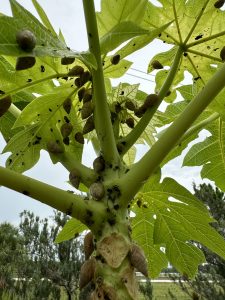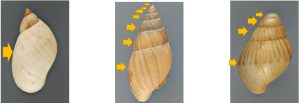
The ding of my phone recently alerted me to a message from one of our vegetable growers in Martin County. He noticed a proliferation of snails climbing his papaya trees and wanted to know what they were. He shared a photo (at right) showing the snails covering a papaya trunk and leaves, splotches of snail poop dotting their paths as they crawled along. I reached out to a few of our UF specialists through the UF/IFAS Distance Diagnostic and Identification System (DDIS), and received a response back from Lyle Buss, Sr. Biological Scientist and Insect ID Lab Manager. Lyle reported these mollusks were a species of Bulimulus, which were first found in Florida in 2009. The snail is still spreading into new areas, and during a subsequent site visit to a Martin County nursery, I tentatively identified it among ornamental plants along a field border. UF researcher Dr. Lauren Diepenbrock of the UF/IFAS Citrus Research and Education Center in Lake Alfred has been studying the Bulimulus snail as an emerging pest of citrus, and she shared current research updates with me for this blog. The information that I’m sharing here is summarized from her presentation “Bulimulus Snails: An Emerging Citrus Pest.”
Be on the lookout
The Bulimulus snails we have here are either B. sporadicus or B. bonariensis, sometimes referred to as “peanut snails” or “ghost snails.” Not to add to any fear they may already be causing, right?! They are about 1/2- to 1-inch in length, conical in shape, with a light brown or tan coloration. As illustrated in the photo above, they tend to aggregate, moving together in large groups. The ghost snail shares similarities with the amber snail and the giant African land snail. All three are conical and of similar color. However, the ghost snail shell has multiple whorls, while the giant African land snail has fewer whorls and the amber snail has only one large body whorl. As its name would suggest, the giant African land snail grows to a much larger size than the other snails, though juveniles may be of the same size as the ghost snail.

Use care to avoid spread
Native to Central and South America and the Caribbean, Bulimulus likely arrived here on more than one occasion and from multiple source locations. Bulimulus are “tree-dwelling” snails. They also climb other things, like microjets, barns, homes, even playground equipment. They were first reported in 2009 in Duval County, where members of a shell club brought them to attention. The ghost snail has since been reported in almost half of Florida’s counties, from the western reaches of the panhandle through the southern tip of the state. With such a wide distribution, Dr. Diepenbrock suspects the snails are likely present in more counties than have been reported so far, including now Martin County. They have been found on cargo, farm equipment, and people, all of which likely assist in their spread to new areas. Scientific studies have documented their spread in fields of peanut, soybean, corn, and cotton, moving distances of 20 feet in the first week after infestation.
Know about its life cycle and growth
Bulimulus hatch from eggs buried under the soil surface. Their shells gradually grow and harden. Calcium is a key element of their diet to develop strong shells. Like many other mollusks, adult ghost snails are hermaphrodites, which means they can produce both male and female gametes. Ghost snails reproduce via sexual reproduction. They live several years, grazing on preferably dead or decaying plant material. In recent years, they have been observed feeding on living plant tissue as well.
Take steps to prevent/manage an infestation
Researchers at the Florida Department of Agriculture and Consumer Services and UF, like Dr. Diepenbrock, are looking for ways growers and others can reduce ghost snail populations and prevent further spread. It’s not easy, in part because the snails’ shell and mucus help them survive inhospitable conditions, including our attempts to kill them. For example, they can seal up their shell opening, preventing moisture loss during periods of drought. Additionally, snail mucus is known to detoxify a wide range of pesticides. With their built-in protections, topical insecticide treatments often do not kill the snails. Though they may appear to be affected, they return to normal within 1-2 days after treatment. Since most pesticides cannot penetrate their shell and slime effectively, researchers are testing different baits. Snails have been found to ingest the baits in container-based lab studies, resulting in mortality. They are now working to determine the best timing for bait applications and testing baits in open field conditions. Researchers are also looking for natural predators that can be used to manage the snails.
No matter the treatment, it’s always easier to manage a pest if it can be detected early, before it builds up a large population. Scout early and often for the ghost snail and other pests. If you need help or if you would like to participate in research studies to evaluate control methods, reach out to your local UF/IFAS Extension office. County Extension Agents collaborate with one another and with UF specialists to help growers, landscapers, homeowners, municipalities and others identify and manage pests affecting crops and landscapes across the state.
 4
4
